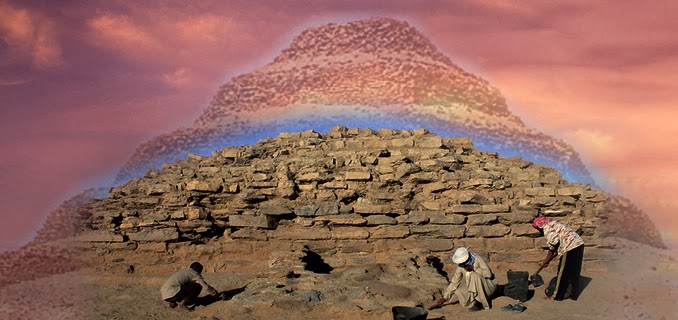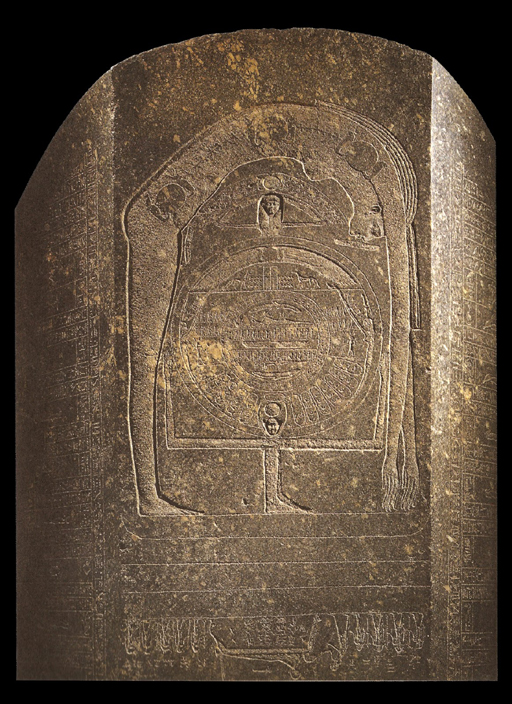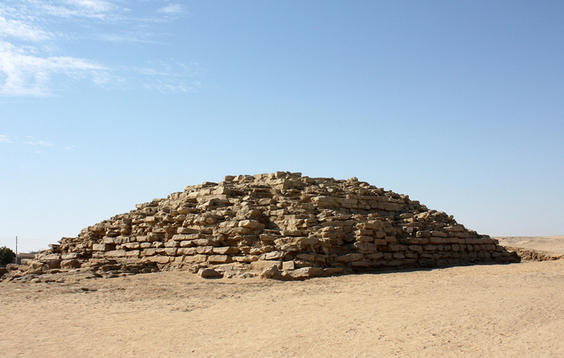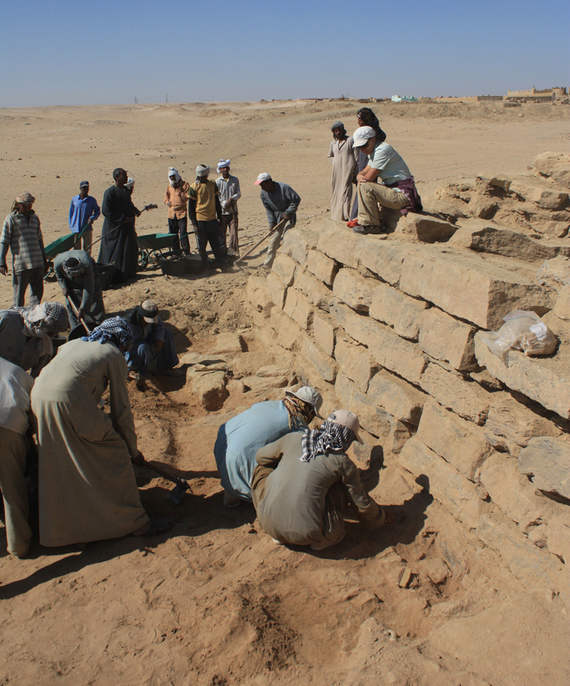It looks like you're using an Ad Blocker.
Please white-list or disable AboveTopSecret.com in your ad-blocking tool.
Thank you.
Some features of ATS will be disabled while you continue to use an ad-blocker.
share:
These are interesting the seven known small pyramids along the length of the Nile which are something of a mystery as they aren't considered to have
been used for burials, the one at Edfu has recently been uncovered what remains.
4,600 year old Pyramid
Seven small Pyramids
Edfu Pyramid Project

Women and children have been found buried at the base from a later period with dedication inscriptions of graffiti, but the pyramids didn't have interiors for burials. Their relationship to the Nile may in some way have reflected the funerary role of that river for Royal burials which passed down it in my opinion, i would also consider that pyramids as reflective of the sacred mountain had the general connotation of 'Place of Establishment'.
Perhaps though they still function in an inter-dimensional sense as this image suggests

Archaeologists recently uncovered a 4,600-year-old step pyramid near the Egyptian city of Edfu. It is the seventh of the "provincial" pyramids built decades before the Great Pyramid at Giza, LiveScience reports. The solid structures are built around Egypt and are nearly identical.
This newest step pyramid stands about 16 feet tall, but when it was new, it towered around 43 feet high. Like the other step pyramids, it was not used for royal burials and contains no inner chamber. And, actually, no one really know what these pyramids were used for.
4,600 year old Pyramid
Seven small Pyramids
Edfu Pyramid Project

Women and children have been found buried at the base from a later period with dedication inscriptions of graffiti, but the pyramids didn't have interiors for burials. Their relationship to the Nile may in some way have reflected the funerary role of that river for Royal burials which passed down it in my opinion, i would also consider that pyramids as reflective of the sacred mountain had the general connotation of 'Place of Establishment'.
It is notable that all were constructed close to important ancient capitals except for Seila (which was located close to the necropolis at Meidum). There also seem to be connections with important constellations (in particular Meskhetyu - the Big Adze) and special events in the Egyptian calendar; notably "Wepet Renpet" (the new year) and "Peret Sopdet" (the rising of Sirius before the inundation).
Perhaps though they still function in an inter-dimensional sense as this image suggests

edit on Kam33183vAmerica/ChicagoTuesday2531 by Kantzveldt because: (no reason given)
Most Egyptologists now days believe the Pyramids weren't tombs at all or were never used as such. Especially the great pyramids since they took
nearly 150 years to construct, and each Pharaoh was highly jealous of one another.
There is also pyramids scattered along the Nile delta, this is probably just one of them. It's interesting that most of these sites are known but never really published because of Egypt's tight grip on people who want to study them from the outside. It's sad really.
But in all honesty, we will never really know what the pyramids were really used for, they vary in size, some have chambers, some don't. Some have people burried in them, some around them. Some were built on existing structures, or were made from existing structures. So much more we can learn from them.
There is also pyramids scattered along the Nile delta, this is probably just one of them. It's interesting that most of these sites are known but never really published because of Egypt's tight grip on people who want to study them from the outside. It's sad really.
But in all honesty, we will never really know what the pyramids were really used for, they vary in size, some have chambers, some don't. Some have people burried in them, some around them. Some were built on existing structures, or were made from existing structures. So much more we can learn from them.
I'm going to throw this out there.
I have often wondered if these may have had a practical reason as well as astrological etc, the landscape around theses always seems very flat.
Is it possible the ancients were also geoforming for shade/agriculture reasons, I can't help but think these may have been intended to be "mountains".
Just an out there thought.
Cheers
I have often wondered if these may have had a practical reason as well as astrological etc, the landscape around theses always seems very flat.
Is it possible the ancients were also geoforming for shade/agriculture reasons, I can't help but think these may have been intended to be "mountains".
Just an out there thought.
Cheers
reply to post by Kantzveldt
Nice thread presentation.
What better way to assure that your tomb isn't vandalized than to put a pyramid on top of it? Maybe these were all royal or "upper class" tombs, but the person is already buried under it when it's started and not within it. Dig a hole, bury the chap, probably your father or grandpa and his or her stuff, put a few massive stones on top of it immediately to assure that nobody digs the stuff up, and then make sure you and your relatives continue to pile stones on top of the grave until a pyramid is formed. One of the ultimate status symbols as well as ultimate grave-robber protector.
Nice thread presentation.
What better way to assure that your tomb isn't vandalized than to put a pyramid on top of it? Maybe these were all royal or "upper class" tombs, but the person is already buried under it when it's started and not within it. Dig a hole, bury the chap, probably your father or grandpa and his or her stuff, put a few massive stones on top of it immediately to assure that nobody digs the stuff up, and then make sure you and your relatives continue to pile stones on top of the grave until a pyramid is formed. One of the ultimate status symbols as well as ultimate grave-robber protector.
To harness energy from the atmosphere.
The only thing we fail to ralise is that the antennas are missing.
The only thing we fail to ralise is that the antennas are missing.
reply to post by Aleister
It's possible i suppose someone is buried underneath them but they aren't considered to have been in the context of Necropoli, though as seen at Edfu a few later burials were placed at the base.
reply to post by strongfp
I haven't come across many of that sort of Egyptologist myself...
reply to post by Treespeaker
They did have the symbolic function of 'mountains', relating to the mountains of the horizon were the sun rose and set, as in the Akhet sign, and from that i would deduce they could have had the general function of 'place of establishment'.
It's possible i suppose someone is buried underneath them but they aren't considered to have been in the context of Necropoli, though as seen at Edfu a few later burials were placed at the base.
reply to post by strongfp
I haven't come across many of that sort of Egyptologist myself...
reply to post by Treespeaker
They did have the symbolic function of 'mountains', relating to the mountains of the horizon were the sun rose and set, as in the Akhet sign, and from that i would deduce they could have had the general function of 'place of establishment'.
edit on Kam33183vAmerica/ChicagoTuesday2531 by
Kantzveldt because: (no reason given)
reply to post by Kantzveldt
I thought of this because of North American Indian burial mounds. I've heard that these mounds were often built atop the home (with the body inside) or body of one individual, a chief or medicine man was often the object of affection, and then sometimes grew to include more individuals. If this occurred in one culture it might be possible that the Egyptian culture used well cut rocks and engineering skill to accomplish the same thing - the honoring of the person as well as making it harder for thieves to get to the stuff buried with them. Maybe the explanation for constructing these pyramids in the first place is as easy as that (although probably not - it was more likely some kind of personal ego competition to build the best one).
I thought of this because of North American Indian burial mounds. I've heard that these mounds were often built atop the home (with the body inside) or body of one individual, a chief or medicine man was often the object of affection, and then sometimes grew to include more individuals. If this occurred in one culture it might be possible that the Egyptian culture used well cut rocks and engineering skill to accomplish the same thing - the honoring of the person as well as making it harder for thieves to get to the stuff buried with them. Maybe the explanation for constructing these pyramids in the first place is as easy as that (although probably not - it was more likely some kind of personal ego competition to build the best one).
Maybe they attempted to emulate the building style of those that came long, long before them.
edit on 2014 by Skyfloating because: (no reason given)
Is it possible that these smaller pyramids acted as waypoints for travellers and merchants. By standing on one face of the structure did it give the
direction and orientation of the next waypoint. Where there oil burning beacons on top to allow night time navigation? So were these objects a route
map and compass all in one?
reply to post by Kantzveldt
i have often wondered if the pyramids were built as a kind of counter balance for the earth .
maybe there was some kind of pole shift or the threat of one .
would it be possible for some one to build a computer model of the earth and remove the weight of the known pyramids and see how it affects the earths spin .
and maybe this model could predict the location of other pyramids that have not been discovered yet .
but as a silver surfer with limited computer skills it will not be me .
so to all the computer boffins out there , can some thing like that be done ?
i have often wondered if the pyramids were built as a kind of counter balance for the earth .
maybe there was some kind of pole shift or the threat of one .
would it be possible for some one to build a computer model of the earth and remove the weight of the known pyramids and see how it affects the earths spin .
and maybe this model could predict the location of other pyramids that have not been discovered yet .
but as a silver surfer with limited computer skills it will not be me .
so to all the computer boffins out there , can some thing like that be done ?
reply to post by InitiumArietis
Perhaps in a sense, the Nile river to which these small pyramids were generally aligned was also comparable to the Celestial river over the length of which the Sun or deceased Pharoah was expected to travel over the length of the night, the Goddess Nut represented this journey arching above in the night time sky.
The points of passage along her body from swallowing the sun to giving birth to it are generally eight, there was also formerly an eighth small pyramid in the Nile Delta, so the journey along the length of the Nile could have been analogous to this, so yes marker points.

reply to post by Aleister
It is considered that all of the small pyramids were built around the same time, either by Pharoah Huni or Snefru, who really liked just building pyramids for the sake of it seemingly, this and an absence of other contemporary burials around them does make it unlikely they were burial places, but who knows...
Perhaps in a sense, the Nile river to which these small pyramids were generally aligned was also comparable to the Celestial river over the length of which the Sun or deceased Pharoah was expected to travel over the length of the night, the Goddess Nut represented this journey arching above in the night time sky.
The points of passage along her body from swallowing the sun to giving birth to it are generally eight, there was also formerly an eighth small pyramid in the Nile Delta, so the journey along the length of the Nile could have been analogous to this, so yes marker points.

reply to post by Aleister
It is considered that all of the small pyramids were built around the same time, either by Pharoah Huni or Snefru, who really liked just building pyramids for the sake of it seemingly, this and an absence of other contemporary burials around them does make it unlikely they were burial places, but who knows...
edit on Kam33183vAmerica/ChicagoTuesday2531 by Kantzveldt because: (no reason given)
Treespeaker
I'm going to throw this out there.
I have often wondered if these may have had a practical reason as well as astrological etc, the landscape around theses always seems very flat.
Is it possible the ancients were also geoforming for shade/agriculture reasons, I can't help but think these may have been intended to be "mountains".
Just an out there thought.
Cheers
Well, they are made of limestone, perhaps something there, for "agriculture reasons" or geoforming.
lets see. for pure speculation and fun, lets see some property of the stone.
Other uses include:
It is the raw material for the manufacture of quicklime (calcium oxide), slaked lime (calcium hydroxide), cement and mortar.
Pulverized limestone is used as a soil conditioner to neutralize acidic soils.
It is crushed for use as aggregate—the solid base for many roads.
Geological formations of limestone are among the best petroleum reservoirs;
As a reagent in flue-gas desulfurization, it reacts with sulfur dioxide for air pollution control.
Glass making, in some circumstances, uses limestone.
It is added to toothpaste, paper, plastics, paint, tiles, and other materials as both white pigment and a cheap filler.
It can suppress methane explosions in underground coal mines.
Purified, it is added to bread and cereals as a source of calcium.
Calcium levels in livestock feed are supplemented with it, such as for poultry (when ground up).[11]
It can be used for remineralizing and increasing the alkalinity of purified water to prevent pipe corrosion and to restore essential nutrient levels.[12]
Used in blast furnaces, limestone binds with silica and other impurities to remove them from the iron.
It is often found in medicines and cosmetics.
It is used in sculptures because of its suitability for carving.
You don't invest that time and effort for nothing.
Worship? Tomb? Practical purpose?
Could be a combination, or none at all.
You build that big, so it last, structurally the shape is engineered to last, it will survive a bit of a beating.
Its hard for me to think all that effort was not more than just ceremonial.
The fact that they are located along the Nile implies the Nile is the key to understanding their purpose. I suspect they acted as watchtowers for
monitoring activity along the Nile. The Nile was the primary "highway" for commerce. And, if an invading army was going to attempt to overthrow the
ruler, they would likely use the Nile to make a fast approach. The height of 40 ft.(approx.) would enable a good vantage point AND ensure the
watchtower was not washed away when the Nile floods annually. When the water level is higher during flood seasons, the guards move the the next higher
tier of the pyramid. The stepped pyramids allow for access to each higher level and a flat zone where guards can set up and monitor activity.
What strikes my imagination, is what else may have been at the peak of the pyramid. What there some kind of communications technology, or visual beacon that allowed a chain of communication along the Nile?
What strikes my imagination, is what else may have been at the peak of the pyramid. What there some kind of communications technology, or visual beacon that allowed a chain of communication along the Nile?
edit on 25-3-2014 by KanuTruth because: Forgot to add some conent.
reply to post by Kantzveldt
wait....seven pyramids running the length of the nile?
Here is more what I am thinking:
wait....seven pyramids running the length of the nile?
Here is more what I am thinking:
KanuTruth
The fact that they are located along the Nile implies the Nile is the key to understanding their purpose. I suspect they acted as watchtowers for monitoring activity along the Nile. The Nile was the primary "highway" for commerce. And, if an invading army was going to attempt to overthrow the ruler, they would likely use the Nile to make a fast approach. The height of 40 ft.(approx.) would enable a good vantage point AND ensure the watchtower was not washed away when the Nile floods annually. When the water level is higher during flood seasons, the guards move the the next higher tier of the pyramid. The stepped pyramids allow for access to each higher level and a flat zone where guards can set up and monitor activity.
What strikes my imagination, is what else may have been at the peak of the pyramid. What there some kind of communications technology, or visual beacon that allowed a chain of communication along the Nile?
edit on 25-3-2014 by KanuTruth because: Forgot to add some conent.
The Egyptian "elite", the people who would commission the building of these, were Esoteric initiates. Power was maintained by a priest class in this regard.
The Nile could very easily have symbolic meaning in multiple ways to the esoteric teachings of the time. The number 7 has well known implications in this regard.
reply to post by Kantzveldt
There is a theory that the great pyramids were made as energy generators, could these smaller pyramids be used as substation like facilities to boost or harness the power of the electricity?
Cool thread! S&F
There is a theory that the great pyramids were made as energy generators, could these smaller pyramids be used as substation like facilities to boost or harness the power of the electricity?
Cool thread! S&F
reply to post by Kantzveldt
Hi and thanks for a well put thread, Yes me again and honest not troling you but we do have similar interests
With the 7 Pyramids I have heard of them before and there are south of sudan a collection of Ziggurats in a similar manor running along the Sudanese River - Sorry cant seem to find the link.
I have been thinking on the idea of the pyramids on a theory that there where prototypes built. Much like the theory of the 'Bent Pyramids' where these where 'failed' projects where the Architects calculations didnt go to plan. To make sure you dont have this same last minute calculation error on somthing like the pyramid of Giza, it makes sense to me the idea that you would commission several, possibly several dosen of different scaled pyramids to get the calculations and logistics as perfect as possible before arrainging the construction of much larger projects. Much as today Architects need to make scale models to get the logistics right, they cannot base everything on the numbers.
Again not going against what you say on this one I personally believe that there is a connection in Egypt to something out of this world (possibly litterally) just that the methods to get there needed practice.
Hi and thanks for a well put thread, Yes me again and honest not troling you but we do have similar interests
With the 7 Pyramids I have heard of them before and there are south of sudan a collection of Ziggurats in a similar manor running along the Sudanese River - Sorry cant seem to find the link.
I have been thinking on the idea of the pyramids on a theory that there where prototypes built. Much like the theory of the 'Bent Pyramids' where these where 'failed' projects where the Architects calculations didnt go to plan. To make sure you dont have this same last minute calculation error on somthing like the pyramid of Giza, it makes sense to me the idea that you would commission several, possibly several dosen of different scaled pyramids to get the calculations and logistics as perfect as possible before arrainging the construction of much larger projects. Much as today Architects need to make scale models to get the logistics right, they cannot base everything on the numbers.
Again not going against what you say on this one I personally believe that there is a connection in Egypt to something out of this world (possibly litterally) just that the methods to get there needed practice.
I think many small (bad quality build) pyramids are just copy's from the great (real) Pyramids. The same you see in Peru, very ancient (very good
quality and often very hard stones) and much later the inca's and so on making their own stonework (but very poor quality and just not impressive and
I'm sure the very good quality much older ones will survive the later stonework with easy (made most likely to honor (for them holy (ancient)
stoneworks).
Also they say they dated this (poorly build) pyramid to 4,600-years old (how??). I guess they date(d) with the ''knowledge'' how old the great pyramids are (just a few decades apart between the Great P and these poorly much smaller pyramids!!!), so they assume and tell us how old they are (which they just don't know).
Build a few decades before the Great Pyramids and in no way comparable (build quality) to the Great Pyramids.. right that makes sense. I'm pretty sure these bad quality & small pyramids are much newer then the Great Pyramids made in an attempt to achieve the same as (their ''gods'') for giving honor - and people just like to ''copy stuff''.
Also they say they dated this (poorly build) pyramid to 4,600-years old (how??). I guess they date(d) with the ''knowledge'' how old the great pyramids are (just a few decades apart between the Great P and these poorly much smaller pyramids!!!), so they assume and tell us how old they are (which they just don't know).
Build a few decades before the Great Pyramids and in no way comparable (build quality) to the Great Pyramids.. right that makes sense. I'm pretty sure these bad quality & small pyramids are much newer then the Great Pyramids made in an attempt to achieve the same as (their ''gods'') for giving honor - and people just like to ''copy stuff''.
edit on 25-3-2014 by Plugin because: (no reason given)
reply to post by Maltese5Rhino
I don't think it likely they were any sort of construction learning process as their construction is so rudimentary it wouldn't have stretched the Egyptians in any way, nor is a practical design for a watchtower or beacon, almost certainly they had religious significance.
There was a river journey made by the Pharoah in death to the Northern Necropolis but that began at Abydos, this did relate though to translation along the Milky Way to which the Nile was comparative, complications arise with the South-North orientation, in that the normal translation of the Sun from setting to rising is of course a West-East affair along the ecliptic plane, the role of the Milky Way may have been a course for the Ba taking it's place amongt the imperishable stars of circumpolar North.
This Egyptian cosmological world map does illustrate this concept of the two passage or river ways, with the body of Nut probably equating with the ecliptic plane and seen beneath the Galactic/Milky Way.

reply to post by bigfatfurrytexan
I'm sure there was an esoteric element to the progression along the Nile also, this is the Egyptians afterall
I don't think it likely they were any sort of construction learning process as their construction is so rudimentary it wouldn't have stretched the Egyptians in any way, nor is a practical design for a watchtower or beacon, almost certainly they had religious significance.
There was a river journey made by the Pharoah in death to the Northern Necropolis but that began at Abydos, this did relate though to translation along the Milky Way to which the Nile was comparative, complications arise with the South-North orientation, in that the normal translation of the Sun from setting to rising is of course a West-East affair along the ecliptic plane, the role of the Milky Way may have been a course for the Ba taking it's place amongt the imperishable stars of circumpolar North.
This Egyptian cosmological world map does illustrate this concept of the two passage or river ways, with the body of Nut probably equating with the ecliptic plane and seen beneath the Galactic/Milky Way.

reply to post by bigfatfurrytexan
I'm sure there was an esoteric element to the progression along the Nile also, this is the Egyptians afterall
edit on
Kam33183vAmerica/ChicagoTuesday2531 by Kantzveldt because: (no reason given)
new topics
-
Former Labour minister Frank Field dies aged 81
People: 1 hours ago -
SETI chief says US has no evidence for alien technology. 'And we never have'
Aliens and UFOs: 2 hours ago -
This is our Story
General Entertainment: 5 hours ago -
President BIDEN Vows to Make Americans Pay More Federal Taxes in 2025 - Political Suicide.
2024 Elections: 7 hours ago -
Ode to Artemis
General Chit Chat: 8 hours ago
top topics
-
University student disciplined after saying veganism is wrong and gender fluidity is stupid
Education and Media: 16 hours ago, 14 flags -
President BIDEN Vows to Make Americans Pay More Federal Taxes in 2025 - Political Suicide.
2024 Elections: 7 hours ago, 12 flags -
One Flame Throwing Robot Dog for Christmas Please!
Weaponry: 12 hours ago, 6 flags -
Should Biden Replace Harris With AOC On the 2024 Democrat Ticket?
2024 Elections: 14 hours ago, 6 flags -
SETI chief says US has no evidence for alien technology. 'And we never have'
Aliens and UFOs: 2 hours ago, 4 flags -
Don't take advantage of people just because it seems easy it will backfire
Rant: 12 hours ago, 4 flags -
Ditching physical money
History: 12 hours ago, 4 flags -
Ode to Artemis
General Chit Chat: 8 hours ago, 3 flags -
God lived as a Devil Dog.
Short Stories: 17 hours ago, 3 flags -
Former Labour minister Frank Field dies aged 81
People: 1 hours ago, 3 flags
active topics
-
President BIDEN Vows to Make Americans Pay More Federal Taxes in 2025 - Political Suicide.
2024 Elections • 10 • : pianopraze -
Thousands Of Young Ukrainian Men Trying To Flee The Country To Avoid Conscription And The War
Other Current Events • 126 • : Xtrozero -
whistleblower Captain Bill Uhouse on the Kingman UFO recovery
Aliens and UFOs • 18 • : Jukiodone -
University student disciplined after saying veganism is wrong and gender fluidity is stupid
Education and Media • 38 • : Consvoli -
One Flame Throwing Robot Dog for Christmas Please!
Weaponry • 9 • : crayzeed -
So this is what Hamas considers 'freedom fighting' ...
War On Terrorism • 230 • : FlyersFan -
SETI chief says US has no evidence for alien technology. 'And we never have'
Aliens and UFOs • 18 • : Consvoli -
The Reality of the Laser
Military Projects • 34 • : Zaphod58 -
Remember These Attacks When President Trump 2.0 Retribution-Justice Commences.
2024 Elections • 52 • : TzarChasm -
Ditching physical money
History • 15 • : crayzeed



